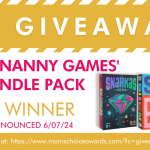Mom’s Choice Awards is excited to announce another post in our interview series where we chat with the inventors, designers, publishers, and others behind some of our favorite family-friendly products.
Welcome, Mom’s Choice readers! Today we have back with us Anne-Marie De Witt, the co-creator of Fireside Games, whose latest—Ultimatch—recently won a Mom’s Choice Award. These popular games, created by Anne-Marie and her husband, Justin (also featured in an earlier interview), let players work together in games known for quick play and collaborative decision-making that some call “positively addicting.”
 MCA: Welcome back, Anne-Marie! Won’t you start us off by telling us something about yourself?
MCA: Welcome back, Anne-Marie! Won’t you start us off by telling us something about yourself?
I’m the co-owner and co-founder of Fireside Games with my husband, Justin De Witt. While my core responsibilities are to handle the business, sales, and marketing sides of the company, I’m also very active in game design and development, which I love. I’ve been a speech-language pathologist, a copy editor, the head of product development at an educational publishing company, a freelance writer and editor, and a number of other things. Diversity is the source of my inspiration. I’m too curious to be satisfied with a single interest, and running a small board game publishing company constantly supplies me with new avenues to explore.
MCA: Can you tell us about the journey that led you to create your award-winning product?
Ultimatch started with Justin’s idea to build on simple matching games. His twist was to allow people to add and subtract to match numbers, to mix primary colors to match secondary colors, and to get some special benefit if you matched both color and number. But the competitive card-shedding game he built felt too flat. We had been changing up the game play for a while, and we just weren’t happy with anything. A spark was missing.
Then, early one morning after driving him to the airport to fly to a game design conference, I had a flash of inspiration. What if the players were working together to shed cards from the table but couldn’t talk about the cards in their hands? They could make observations about what cards would be helpful but couldn’t reveal if they had them. And what if they had a shared hand of cards face up that gave them additional information but were also limited resources that should be used carefully?
From there, I realized that the special reward for matching both color and number would be to draw two cards: one for the shared hand and one for your own hand. As you are shedding cards from the center of the board, you are shedding cards from your own hand. You need to match both color and number (what would become known as an Ultimatch) in order to get enough cards available to make the matches and clear the pyramid of cards. I arranged the cards on the table, took a picture, texted the basics of my idea to Justin, and fell back to sleep. We experimented with different shapes later, but we came back to the pyramid. Nothing worked quite as well because of the way it narrows your options the more you progress in the game.
 MCA: Could you tell us about the research involved in the development of Ultimatch?
MCA: Could you tell us about the research involved in the development of Ultimatch?
Most of our research had to do with the packaging. We went to our local Target and took pictures of other card games and thought about what would stand out among them but also looked like it belonged. Nothing on the shelves then was as bright and colorful as the packaging we would end up with.
MCA: How does your game address a need or solve a problem for families and educators?
Ultimatch helps families looking for a game that doesn’t end in tears or bad feelings at the end of the night. Because all of the players are on the same side, they experience the highs and lows of the matches together and share the victory or loss. It’s also great for supporting addition, subtraction, and some simple color theory. Educators will find a fun use for the game in the classroom to help solidify those concepts.
MCA: What sets your game apart from other similar products in the marketplace? What unique features or benefits does it offer?
Ultimatch differs from its key competition because it offers multiple target cards and a variety of ways each card can be used. Usually, more than one card is showing on the pyramid, which allows you to pick which card you want to match. And all of the cards in the game are unique, so you have to think about how you want to use each card. Is it better to use the red 4 to add it to the blue 3 and shed the purple 7 showing in the middle of the pyramid? Or is it better to match the red 4 to the red 1 on the side and open up another card for matching? Lots of fun choices and decisions about what gives you flexible options and what helps you meet your goal.
MCA: Can you share any memorable stories or feedback from customers who have played Ultimatch?
One of my favorite memories was of W. Eric Martin, editor of Board Game Geek, who played it with Justin over and over at the Game Manufacturers Expo last year. Before the show had ended, he had written and published an article declaring Ultimatch the game of the show. That was a very satisfying moment.
MCA: That must have been very rewarding! Tell me, as a creator/developer, how do you ensure safety and suitability for your target audience?
We always playtest our games with a wide range of players in all respects, including age and play style preferences. We want to make sure we are developing a game with a cohort in mind. We also conduct thorough safety testing on our games to ensure there are no hazards present during play.
 MCA: What challenges did you encounter during the development your product, and how did you overcome them?
MCA: What challenges did you encounter during the development your product, and how did you overcome them?
The biggest challenge was coming up with a system that was as fun as the key mechanic. Solving that took a lot of thinking, an unexpected inspiration, and the fortitude to test, test, test it.
MCA: How do you juggle the demands of running a business with the creative life needed to design games?
I find the challenges I face as a business owner open me to experiences that feed into possibilities within game designs. Games at the end of the day are systems, and as a business owner, I have to think about systems all the time. When I encounter a problem with a system in any facet of my life, it usually leads to to a new idea about how to design a world that needs a similar way of operating on the table. And that usually ends up with other people having a lot of fun, which I love knowing I helped shape.
MCA: Looking ahead, what are your plans or goals for expanding or improving Ultimatch?
Right now, our focus is on expanding our catalog. We’re best known for Castle Panic, a cooperative adventure game about defending a castle. People most love our games that are story-based experiences. And we have two coming in 2025. The first is Please Don’t Burn My Village, which is set in the world of Castle Panic. You are bribing the dragon from The Wizard’s Tower expansion not to burn your village. It’s an accessible market game with a surprising push-your-luck ending that keeps the tension high.
The second is Ham Helsing, based on the graphic novel series of the same name. In the game, you play as one of four characters to build skills and earn money by defeating the Villain’s minions. And you need that money to upgrade your cards with transparent overlays that power you up to defeat the Villain before he or she destroys Mud Canyon. There are four different Villains, each with their own special abilities, so the replayability is quite high.
Having said that, I’d love to see new IPs applied to Ultimatch to see what we could build on the core mechanics. But there are no concrete plans to do so right now.
MCA WRAP: Anne-Marie, it’s been a real pleasure having a chance to talk to you again and learn what other products you have in the works. Thanks so much for joining us!
You can learn more about Anne-Marie De Witt and her award-winning product, Ultimatch. by visiting his MCA Shop page.






4 Comments on “Interview with Mom’s Choice Award-Winner Anne-Marie De Witt”
Interesting interview
Great ideas.
I think my kiddos would love this!
firesign games are awesome. thank you for this article